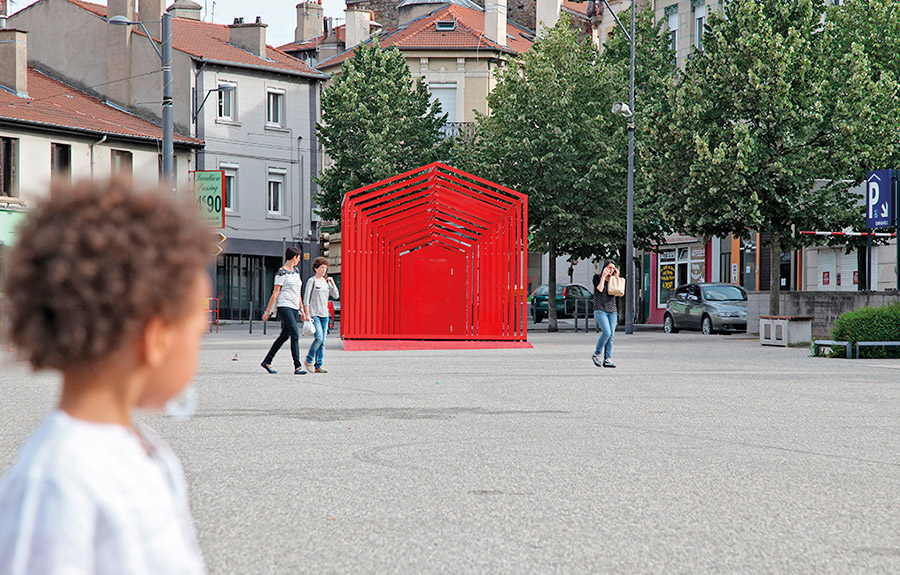2015 - Merit Award
Saint-Etienne, France
CONTEXT
Public areas are singular places that are used for cultural as well as commercial manifestations while being unused the rest of the time, thus making them available for events. They mainly display a vast central area surrounded by retail stores and residential dwellings.
Some of them are unfortunately poorly organized and badly used. Neighboring retailers are closing down and maintaining some commercial activity is difficult.
However, public squares make ideal places in order to welcome a wide variety of events: markets, thrift sales, concerts, festivals, expositions, etc. They are equipped with electrical outlets, public sanitation and are usually quite vast.
With this frame of mind, how can we address daily issues such as esthetics, social and economic impact while safe keeping their event focused character.

DESCRIPTION
In 2015 and within the framework of a major European event, a designer in cooperation with a businessman specialized in fabricating technical products made of aluminum, proposed a urban furniture concept in order to contribute and help foster the identity and attractively of a public area experiencing a lack of activity: The NESTING CUBE.

The Nesting Cube, what is it ?
The Nesting Cube is an object that brings back to life architectural concepts (white fabric awnings, traditional wood house structure, multicolor sun shades ...) that are traditionally used during public manifestations such as fresh produce markets, Xmas markets, festivals, etc. within a furniture concept mixing functionality, esthetics and serviceable design.
It is made of 10 mobiles and modular nesting structures that are fashioned in the typical shape of a house, positioned around a permanent storage space.
A sculptural furniture, attractive and functional.
While imbricated, the 10 red modules constituting the Nesting Cube makes a graphical contemporary structure that furnishes and brings dynamism to the area. The shadows of the nested cubes creates on the ground a design made of lines, thin and thick, that keep changing during the day. The challenge is to recreate an identity to this area thanks to an esthetical object, enticing photographers and pleasing to look at by the general public.
Opened, the 10 structures are made available to the public in order to organize and foster cultural and commercial events. Users are welcomes to deploy the structures within the public area, to set them up and to display them as they wish. Erecting each structure is easy and quick thanks to the dolly that is housed within the smallest house and the integrated hardware used to install and fastened the fabric awnings. It takes only 30 minutes for two people to open the Nesting Cube and set-up the 10 individual structures.
The structure being always in place on site brings great time savings and comfort of use. It is not necessary to load / unload equipments nor bring them to a storage space. No outside help from technical city services employees is needed, making the Nesting Cube a highly functional and easy to use piece of urban furniture.
The Nesting Cube is a designer piece that positions itself within an innovating and socially interacting concept since it invites passers-by and retailers to actively participate to the economical and social development of their town through the offering of a wide scope of possible events. Local inhabitants become involved in their own public spaces as well as developing their own input on the impact of design in the urban environment.
The Nesting Cube is also a backed by a digital platform where users can book their spaces and communicate / exchange with the public regarding the program of events taking place.
All of those strengths makes the Nesting Cube an incubator of services that are modern, real and virtual, interactive and community orientated. A tool that contributes to the transformation of the local economy, and to its social and territorial development.
The strong visual imprint of the Nesting Cube signals the presence of events and bring a better visibility to any happening. The red houses catch the eye, people are intrigued, drawn and rediscover a forgotten public area. From now on, this space becomes part of an urban trail and its importance is reborn within the city urbanism.
Since the Nesting Cube has been set-up the neighborhood retailer’s association has been reformed, revitalized and regularly organizes cultural events, markets, garage sales, neighborhood parties while promoting its activities by displaying and using the 10 booths from the Nesting Cube.
